Panthera
Latest updated Saturday, January 4, 2025, 91 comments
Images | Particulars | More about | Background and history
Plans, Panthera - 185 EUR
Purchase
Panthera
Panthera is a new surfski sea-kayak hybrid – simply put a surfski with a kayak deck. But that would be an over-simplification. Even if the hull is a Spindrift there is also a noticeable influence from Njord. I expect the performance to be a tad less extreme than that of a thoroughbred surfski, but yet manageable should the paddler develop an acute desire to surf diagonally in high speed on large waves. I also expect competent paddlers to be able to keep Panthera at speeds well above hull speed á la surfskis off following seas.
Basically, Panthera is so close to a genuine surfski that a rudder is needed to meet the potential (more about the difference here). An under-the-hull rudder with a surfski type of pedal set is, of course, the best, but for fast touring, a rudder on the stern will do fine – preferably with one of the larger blades. With a full touring load, the kayak settles down to more directional stability for relaxed long-distance paddling.
John Abercrombie, who built the first Panthera (see below) published this review after a short trial when mid-winter Canada offered a few days with open water.
I thought I'd share my first paddling impressions of my new boat (Bjorn Thomasson Panthera) from a very short outing this afternoon.
I like it! ;-)
Hopping in the boat, the initial feel is a lot like Frej - it feels compact and 'ready to go' but not at all 'twitchy' or unstable.
Secondary stability is excellent- I can set it up on edge very easily, and it stays there. It rolls easily - and I'm not an accomplished roller, at all. The low back deck (like Frej) makes sweep rolls easy.
It feels quick - with the footboard, it's easy to put my knees and feet in the middle of the boat and get good rotation and drive. I'll need to put the GPS on it for a longer outing to get some data on the speed.
Maneuverability:
With the rudder down, it goes where it's told with no fuss.
Rudder up - it's quite agile even when not edged (flat). Responds well to sweep strokes which skid the stern around easily, and bow rudder strokes work well. When set on edge, the steering strokes work even better (as you'd expect). Hanging draw stroke works well.
I'll let you know how it does in a breeze and waves, and also with some more weight in the boat, as the season progresses.
John Abercrombie
Arto Nikula has published a photoblog with a lot of instructive Panthera construction photos.
Peter Träisk build an interesting integral rudder on his Panthera (text in Swedish).
Panthera L
I got a request from a tall and heavy paddler about a roomier Panthera, so I added a little deck height (2.5 cm) and beam (1 cm) on the same LOA and named the result Panthera L. It loads 15 kg more on the design waterline and has 20 liters more internal volume. Are you a big guy (>190 cm/95 kg), don't believe in traveling light or have other good reasons you may want to add Panthera "L" in the comment field when ordering.
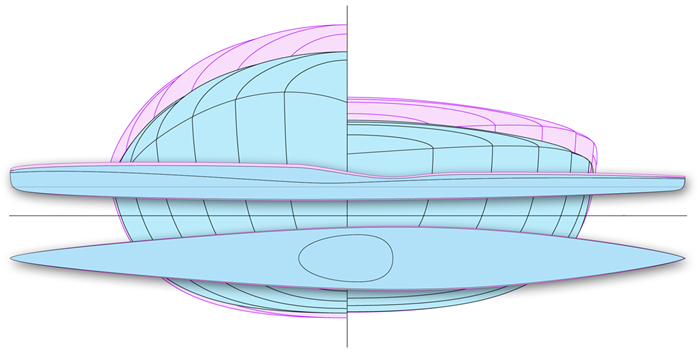
Compare the outer dimensions of Panthera and Panthera L
Panthera stitch-and-glue
If you are not sure of your competence as a boat builder, there is an easier way to almost the same kayak. Together with Petruskajak in Tranås, Sweden I have developed a plywood version of Panthera, that can be built at Petrus's well-known 8-day classes, and can also be purchased as kits for home completion.
The stitch-and-glue concept means that precision cut CNC panels are "sewn" together, the joints are stabilized with glass fiber/epoxy, and the outside is laminated in glass fiber/epoxy. The result is a light, stiff, and strong kayak in roughly half the time of a striper, or a quarter of the time if you have ambitions including decorative stripping with different wood species ;-)
An S&G kayak design requires single-curve surfaces with hard chines. The disadvantage is a slight increase in turbulence and friction and a slight loss of internal volume. The difference is almost imperceptible in actual use and has to be weighed up against the quick and easy construction, and, in most cases, a low weight that few amateur builders otherwise can match. The plywood prototype tipped the scale at 16,5 kg including Kajaksprt hatches and a Smarttrack rudder system
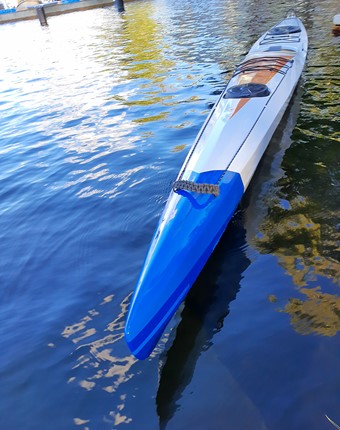
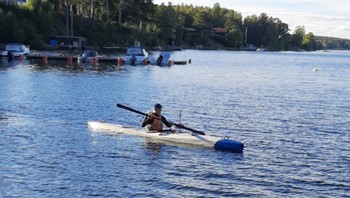
Particulars
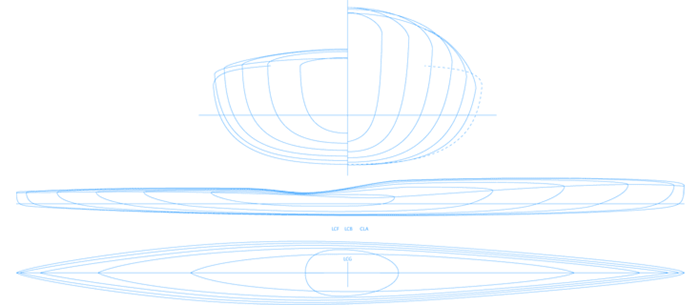
| Length¹ |
560/552 cm (overall/WL) |
| Beam |
52/49 cm (overall/WL) |
| Draft |
10 cm |
| Cockpit¹ |
78x39 cm |
| Height¹ |
28.5/18 cm (in front of/behind the cockpit) |
| Weight² |
16-19 kg |
| Displacement/volume⁶ |
120 kg/375 litre |
| Prismatic coefficient |
0.563 |
| Wetted surface |
2.07 m² |
| Stability⁵ |
3/4 (initial/secondary stability) |
| Intended use |
Fast touring, surfing, sea kayak racing |
| Length¹ |
560/552 cm (overall/WL) |
| Beam |
53/50 cm (overall/WL) |
| Draft |
11 cm |
| Cockpit¹ |
80x40 cm |
| Height¹ |
31/20 cm (in front of/behind the cockpit) |
| Weight² |
17-20 kg |
| Displacement/volume⁶ |
135 kg/395 litre |
| Prismatic coefficient |
0.563 |
| Wetted surface |
2.12 m² |
| Stability⁵ |
3/4 (initial/secondary stability) |
| Intended use |
Fast touring, surfing, sea kayak racing |
* These dimensions can be adapted to suit personal needs or wishes.
** Depending on type of wood, equipment, care with epoxy usage, sanding etc. etc.
*** The speed numbers are based on mathematical standard formulas (175 lb paddler + 30 lb carco weight) and corrected from the kayaks actual performance om trials, on tours and in races.
⁴ Calculated resistance in 4 and 5 knots (at nominal load capacity).
⁵ Initial stability and secondary stability on a subjective scale, where 1 is very tippy and 5 is very stable.
⁶ Displacement is kayak + paddler + load. Count off the kayak weight to get the load capacity.
Plans
The plan sheets contain the information needed to build the kayak/canoe. Station molds, stems and construction details are full scale. For kayaks the recommended cockpit size is shown half scale with offsets for a full scale drawing and advice on altering the size. On the plans you will also find advice on how to shorten or lengthen the craft. Lines and construction drawings are in metric scale 1:10.
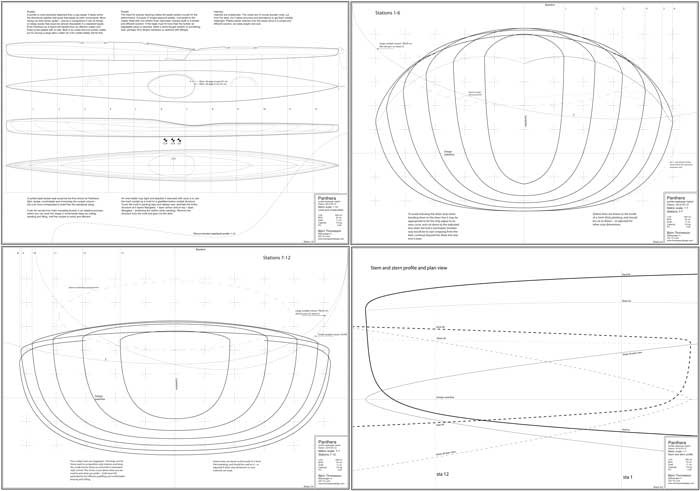
 The illustrated step-by-step building manual is in Swedish only, but it is available online in English: it covers all steps in detail and will guide first-time builders through the project.
The illustrated step-by-step building manual is in Swedish only, but it is available online in English: it covers all steps in detail and will guide first-time builders through the project.
Plans, Panthera - 185 EUR
Purchase
Minimum window dimensions to get your kayak out from the workshop:
53x28cm
Background and history
On the far side of the Atlantic, there has been for some time a certain interest in surfskis with kayak deck. Dan Caouette got an order for a Spray with deck and built this beauty.
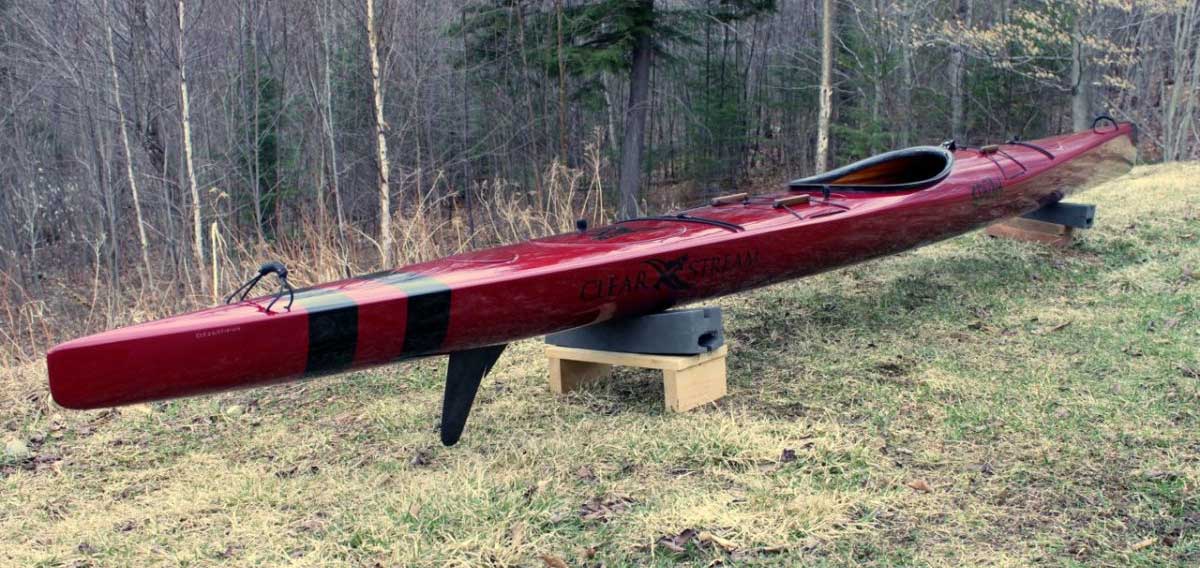
John Abercrombie and I have exchanged ideas and details for a similar project via mail for a while. It got me looking in my inspiration folder where I hide those more or less whimsical ideas that occasionally might end up in a project: this time a surfski-kayak with lines inspired from the beautiful and exciting Jaguar CX75, an electric hybrid concept supercar, built to celebrate the Jaguar 75th anniversary.
While being a very exciting car – electric motors on all four wheels (4WD without differential and complicated power distribution circuitry) at 778 HP total power, two micro gas turbines from Bladon Jets charging the batteries to achieve 900 km range, and that can use almost any fuel (diesel, biofuel, natural compressed gas, ordinary petrol) emitting 28gr CO2/km over the entire distance – it is also one of the most well-designed cars I have seen for a long time. While many supercars seem to be the accumulation of individually attractive lines and areas that don't quite add up, sometimes backed up by wow-gadgets, the Jag feels like a successful unified design job, looking good from every viewing angle, exuding power, function and elegance. Unfortunately, the global economic crisis erased much of the market for ridiculously expensive supercars, and the project was discontinued in 2012.
There were a lot of photos and drawings in my idea folder, and I started playing with some of them on the digital drawing board.
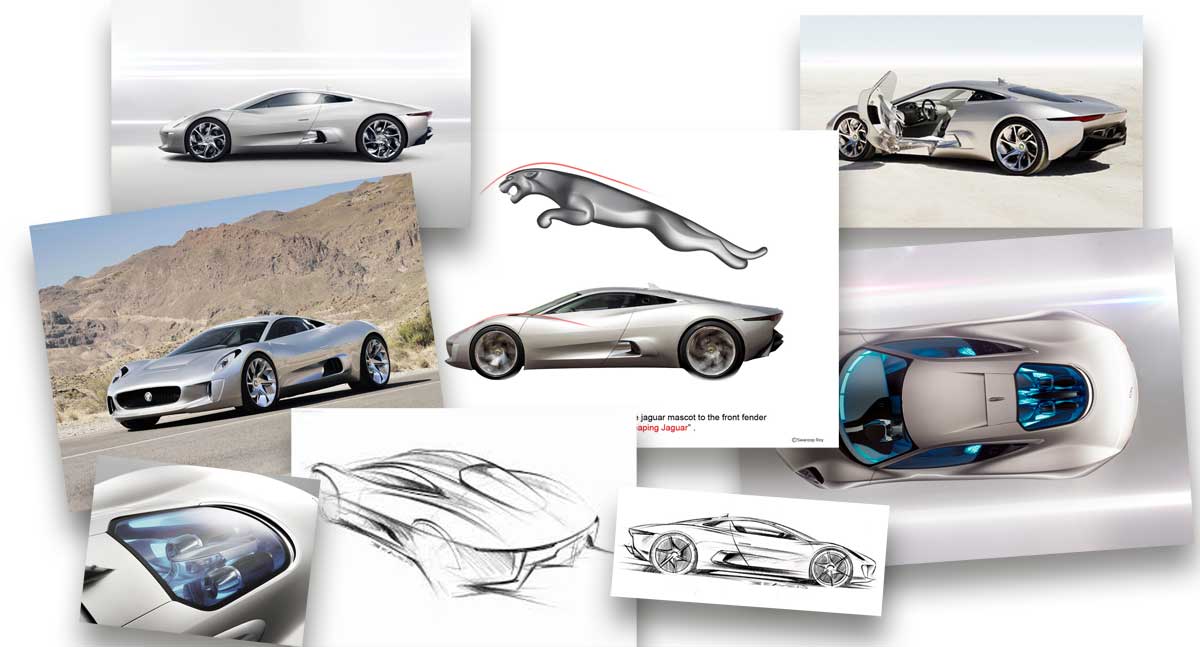
The starting points what was to become Panthera in 2015 were: surfski-like performance (superb maneuverability, tamed with an efficient rudder), stability on par with Frej (John referred to a Frej he built some time ago), interior volume as Njord, deck height to accommodate the pedal system of choice, a dip in the sheer line to allow for deep cutouts to improve the stroke geometry – and of course: as much beauty and interest as I can design into the lines ;-)

Visually the Jag has been inspiration, but a kayak is a much simpler shape than a car, lacking most of the details that spice up a well-designed car: windows, lights, wheelhouses, air intake, exhaust etc, so in the end, it was not much more than a sweeping sheer line that I could transfer to the kayak. More can be achieved by painting schemes and decals – but for me and for now, it is an interesting appearance on an efficient hull I focussed on. Superficial styling will be left to the builders. For now...
The result is a yet unnamed kayak and plans shipped across the Atlantic to John, who finished the prototype – a real beauty in a black hull and copper-colored deck (inspired from Dan Caouette's 5-part Black Pearl). The project has been discussed and commented on the Kayak Building Forum.

The name Panthera is the Latin name for Jaguar: Panthera Onca.
A Panthera under construction in Luxembourg:
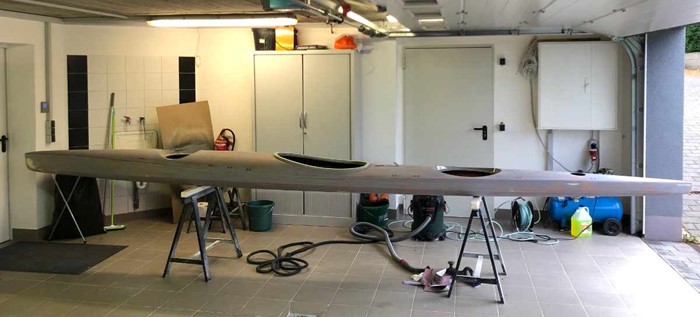
If someone wants to go berserk with the painting scheme, here is an old idea that was abandoned some years ago when Point 6.5 beat me to the name Orca for a surfski. A sea predator would, of course, be a more appropriate inspiration for a kayak than a land predator – but don't blame me if a real Orca takes a fancy to the little pretty kayak-orca…

Dan Caouette built an Orca-styled baidarka recently. Very nice!
Panthera Special
Two special Pantheras were designed for long-distance competitions and extreme paddling, both dimensionally adjusted for their owners and built by Petruskajak in Tranås:
For the 2018 season a Panthera for Fylkir Saevarson, with Icelandic flag decor...

...and for 2019 a Panthera for Jacob Norris, in English racing green (the photo is from M24KC, Malmö Kanotklubb's 24-hour kayak challenge)
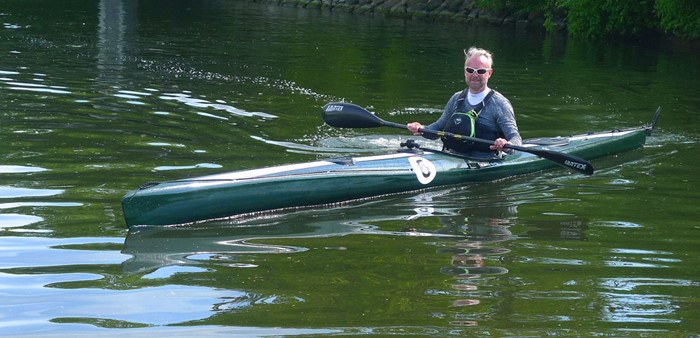
"Den nye Panthera er blevet min bedste kompis, det er muligvis Danmarks hurtigste havkajak. (The new Panthera has become my best friend, possibly Denmark's fastest sea kayak)"
A record-breaking Panthera!
After a couple of years, Saevarsons Panthera got a new color scheme and was used by Erik B. Jørgensen in an attempt on the "Around Denmark by Kayak". He managed to set a spectacular new record:14 days! The old record was 18 days.
Here is the design sketch for Erik's Panthera. The idea was a gunmetal base color (Erik has a military background) and the Danish flag.

...and here is a photo from the actual paddling (Photo: Claus Lillevang).
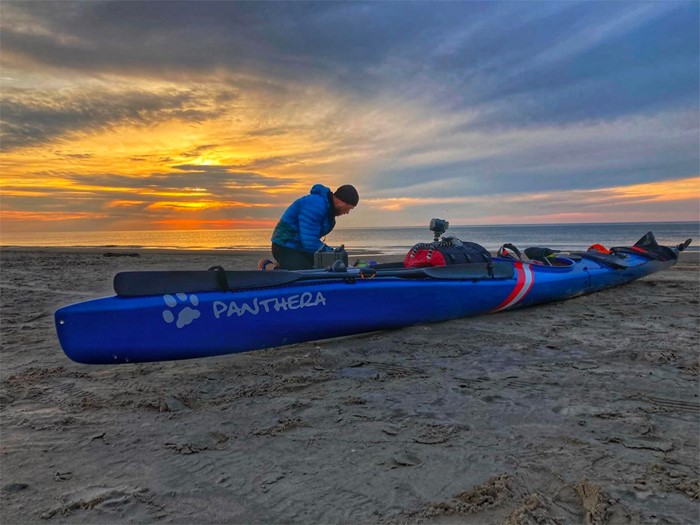
For more info: see comment 67 below (Thanks Jenny!)
And here is Erik's own story.

